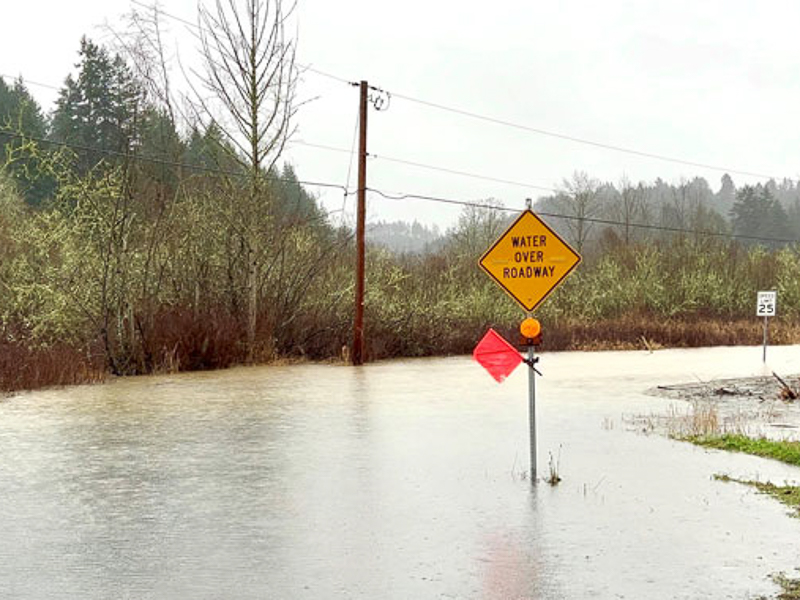
A dairy farm in the Chehalis River basin during the January 2022 floods.
Last winter’s floods damaged river levees and streambank protection across western Washington. Since then, public works departments and other flood management agencies have been working diligently to repair these protective structures.
These agencies work to reduce flood risks to their communities in non-structural ways, too. When a community is built in a floodplain, developing projects that protect people means working around infrastructure and buildings that already exist. In addition, solutions must not shift the flood risks from one community to another.
Modern flood management takes these factors into account and strives to restore a floodplain’s natural capacity for handling floodwaters, which protects lives and homes while also benefiting fish and wildlife.
The road in front of our Bellingham Field Office was completely covered by floodwaters from Squalicum Creek in November 2021.
This integrated approach includes projects like buying vulnerable properties, elevating buildings, setting back levees to allow floodwaters to spread safely, and reconnecting rivers to their side channels. While no single solution will take away all flood risks, these steps can work together to greatly reduce the impact of flooding.
How much does it cost to reduce flood risks?
Preventing or reducing flood damage is expensive. Project costs are generally beyond what a local community can pay for by itself. For an idea of the scale, consider a single grant application from a local agency. Whatcom County Public Works, which serves communities that were hit hard by floods in the Nooksack River basin in November 2021, submitted a grant application for federal funding last spring.
The public works department requested funds to buy 22 properties vulnerable to flooding and to elevate structures on 17 other properties, at a total estimated cost of $14 million. The department identified these willing landowners from an initial list of over 700 properties in flood-prone areas. These 39 properties will be a start—but finding funding in the tens or perhaps hundreds of millions of dollars will be a long-term effort.
Communities throughout Washington can apply for grants to pay for this kind of long-term flood risk reduction work from several different state and federal funding sources. Keep in mind that because state and federal governments plan their budgets far in advance, it does take a long time between applying for grants and receiving the funds. And some sources have limited funding.
State funding for flood projects
There are two state funds for flood planning and risk reduction, Floodplains by Design (FbD) and the Flood Control Assistance Account Program (FCAAP). Both are administered by Ecology and funded through the Washington state budget process, which operates on a two-year cycle called a biennium.
- Floodplains by Design is a public-private partnership led by Ecology, the Bonneville Environmental Foundation, and Puget Sound Partnership. Its goal is to improve the resiliency of floodplains by funding projects that integrate flood mitigation and habitat restoration. Types of projects include acquisitions, levee setbacks, purchases of easements, installing habitat structures such as engineered logjams, reconnecting river side channels, and floodplain modeling.
- The Flood Control Assistance Account Program assists local and Tribal governments with floodplain management planning, flood control projects, and emergency projects.
Federal funding for flood projects
The Federal Emergency Management Agency (FEMA) has three different funds available to help communities reduce risks from flooding and other natural disasters, which they collectively call their Hazard Mitigation Assistance (HMA) grant programs. These are different from the funds that are provided right after a disaster, which are for public infrastructure repairs or for helping individuals. HMA programs are intended to lessen the risks posed by future floods.
Local communities can’t apply directly to FEMA for HMA grants. Instead, they submit proposals to the Emergency Management Division of the Washington Military Department, which coordinates the state’s applications for these funds.
Two of the HMA programs award grants on an ongoing basis through a national competitive process, meaning that Washington must compete against other states for these funds. The third program, the Hazard Mitigation Grant Program, is only available to communities with a Presidential Major Disaster Declaration. Each program requires non-federal matching funds.
The Hazard Mitigation Grant Program is only available to communities after a Presidential disaster declaration. It’s intended to help communities rebuild after a natural disaster in a way that reduces the chance of future losses. Funds can be used for acquisitions, elevations and other retrofits, reconstruction, post-disaster code enforcement, and developing hazard mitigation plans.
The Flood Mitigation Assistance Program has the goal of reducing future claims against the National Flood Insurance Program (NFIP). It focuses on projects that reduce flood risk to buildings insured under NFIP, including buyouts and building elevations. Funds can also be used for technical assistance and flood hazard mitigation planning. Grants through the program are typically offered on an annual basis.
The Building Resilient Infrastructure and Communities Program (BRIC) funds projects that reduce flood risks before a disaster, including public infrastructure projects, projects incorporating nature-based solutions, and adoption and enforcement of modern building codes. Over $1 billion was allocated for the BRIC program for fiscal year 2021. BRIC program grants are typically offered on an annual basis.


